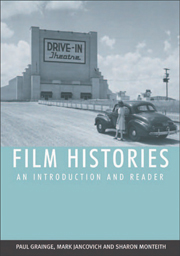Book contents
- Frontmatter
- Contents
- Preface
- Part I Film History from its Origins to 1945
- 1 The Emergence of Cinema
- 2 Organising Early Film Audiences
- 3 Nationalism, Trade and Market Domination
- 4 Establishing Classical Norms
- 5 The Age of the Dream Palace and the Rise of the Star System
- 6 Competing with Hollywood: National Film Industries outside Hollywood
- 7 The Rise of the Studios and the Coming of Sound
- 8 Realism, Nationalism and ‘Film Culture’
- 9 Adjustment, Depression and Regulation
- 10 Totalitarianism, Dictatorship and Propaganda
- 11 The Common People, Historical Drama and Preparations for War
- 12 Wartime, Unity and Alienation
- Part II Film History from 1946 to the Present
- Bibliography
- Copyright Acknowledgements
- Index
1 - The Emergence of Cinema
from Part I - Film History from its Origins to 1945
Published online by Cambridge University Press: 05 August 2013
- Frontmatter
- Contents
- Preface
- Part I Film History from its Origins to 1945
- 1 The Emergence of Cinema
- 2 Organising Early Film Audiences
- 3 Nationalism, Trade and Market Domination
- 4 Establishing Classical Norms
- 5 The Age of the Dream Palace and the Rise of the Star System
- 6 Competing with Hollywood: National Film Industries outside Hollywood
- 7 The Rise of the Studios and the Coming of Sound
- 8 Realism, Nationalism and ‘Film Culture’
- 9 Adjustment, Depression and Regulation
- 10 Totalitarianism, Dictatorship and Propaganda
- 11 The Common People, Historical Drama and Preparations for War
- 12 Wartime, Unity and Alienation
- Part II Film History from 1946 to the Present
- Bibliography
- Copyright Acknowledgements
- Index
Summary
The history of motion-pictures is not easily defined by a single invention or inaugural event. While inventors such as Thomas Edison, and early cinema pioneers such as the Lumiére brothers, have become central to legends surrounding the ‘birth of cinema’, the emergence of cinema was the result of a series of technological and entrepreneurial developments that came together in the 1890s. Seeking to capitalise on new capacities of photographic development, the invention of celluloid, and the refinement of machines that could project images in sequence, a number of individuals saw commercial possibilities in projecting moving images to paying audiences. Cinema did not arise as a fully fledged industry with a set of aesthetic norms and conventions in place, but developed as a novelty entertainment, one of a number of emergent visual forms within popular culture at the end of the nineteenth century.
The invention of moving pictures has complex origins that can be traced back to sixteenth-century experiments with the camera obscura and the use of magic lanterns. While the former was a dark chamber in which an image of outside objects could be thrown upon a screen, the latter was a device that enabled images, painted on glass, to be projected by means of an artificial light source. Magic lanterns were used to present a succession of images for the purpose of telling a story, often illustrating and helping to narrate satirical scenes, theatrical tragedies and miracle plays.
- Type
- Chapter
- Information
- Film HistoriesAn Introduction and Reader, pp. 3 - 20Publisher: Edinburgh University PressPrint publication year: 2007



